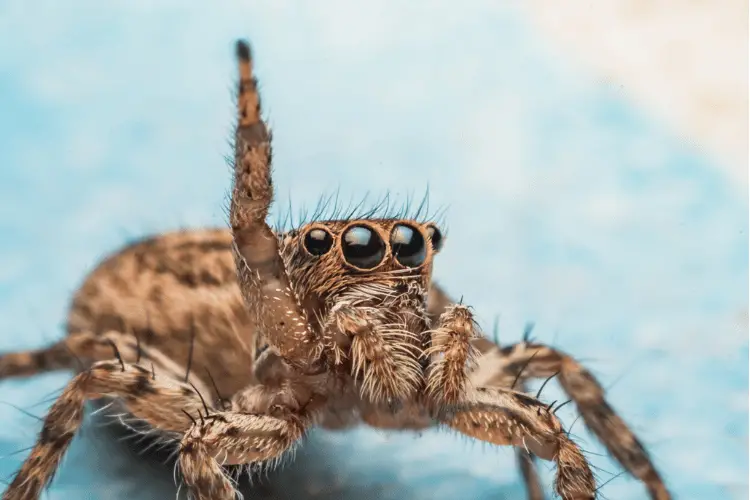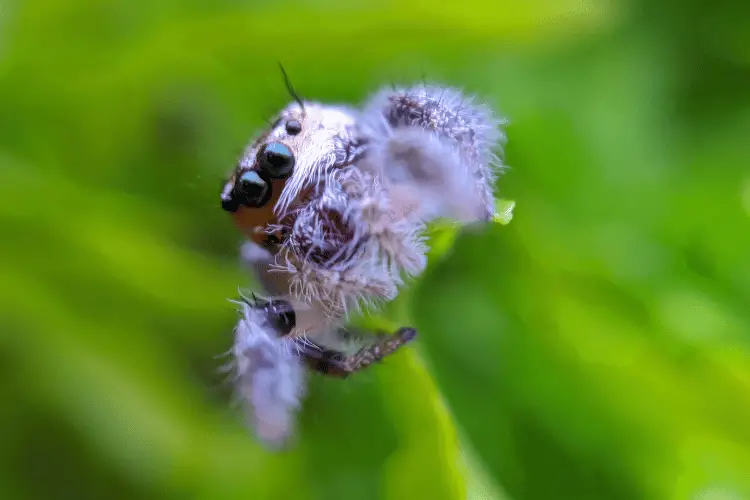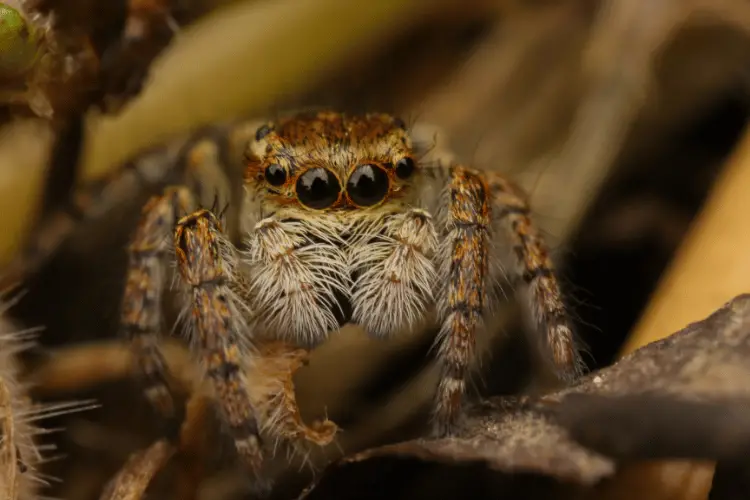We strive to provide you with authoritative, trustworthy, and expert advice. In doing so, the staff at texaswalkabout.com performs extensive research, editing, and fact checking to every post on this webiste. If you feel that this article can improve, please feel free to reach us at staff@texaswalkabout.com
If you Google “cute spiders,” the first images that pop up are going to be of some jumping spiders. These adorable arachnids can be found globally, except for Greenland and Antarctica.
One of the most common regions that host jumping spiders is Texas. A Texas jumping spider comes in multiple species, from zebra options to ant-mimicking ones.
Overall, Texas jumping spiders prefer the outdoors, where there’s vegetation, sunlight, hiding spots, and lots of prey.
Stick around to learn more about these spiders, including their habitat, appearance, prevention, and care.
Texas Jumping Spiders: Overview
As their name suggests, jumping spiders hop around to catch their prey. They originate from one of the largest spider families, Salticidae.
The family consists of over 600 genera and 5,000 species. In turn, jumping spiders can adapt to several habitats except for polar areas.
Over 300 species reside in the U.S. and Canada. Around 100 of those live in Texas, including the Texas jumping spider.
Texas Jumping Spiders: Appearance
Also referred to as the cutest arachnid on the planet, jumping spiders are relatively compact and have eight shorty, stubby legs.
They’re over ⅛ to ¾ inches lengthwise and come in multiple colors based on their species. In the Texas region, they have several patterns with primarily tan and black shades.
Texas Jumping Spider Eyesight
Jumping spiders have over eight eyes. Four of them are at the front. Two are principal, moving. and distinguishably large. Meanwhile, the other two give the spider peripheral vision.
The rest are around the spider’s head and provide a 360-degree view. Their principal eyes have an extensive outer lens and a smaller inner lens.
The inner lens composition allows these jumping spiders to magnify their views, acting like natural binoculars. Meanwhile, the outer lens reveals the images to the retina.
Jumping spiders are master stalkers, thanks to their retinas. They contain muscles that allow them to move up, down, and sideways without moving their eyes.
Most jumping spider species have ultraviolet vision, allowing them to see in greens and blues. In addition, their sight doesn’t only showcase image but depth as well.
They use image-defocusing techniques from their four layers of photoreceptors.
How Do Texas Jumping Spiders Jump?
One of the most arguably worrying instances of seeing a spider is looking at it once, looking away for a second, then looking back and finding it gone.
The Texas jumping spider is no different. It can leap over six inches before landing on its prey. Before jumping, they like to build a silk zipline to stabilize their jump.

The spider species may also jump to escape predators. Besides that, their jumping mechanism comes from a change in their blood pressure or, more accurately, hemolymph pressure.
Their blood rushes to their legs, extending them. Their quick extensions push them skyward.
Where Do Texas Jumping Spiders Live?
Texas jumping spiders can live in various habitats, from rocky mountains to wood piles. In most cases, you’ll likely find the species where its prey is abundant.
Outdoors
Jumping spiders enjoy feasting on ants and fruit flies. In turn, they’ll likely turn up in one of your garden shrubs. If you have an ant infestation, it might stick around for a bit.
You can also find them nestling in large leaves, like milkweed. Plus, they crawl around wood surfaces, such as fences, barns, and tree trunks.
Even though they’re spiders, these species aren’t exactly web weavers. Instead, they prefer to use their webbing as a zipline for their jumps.
One of the other times jumping spiders spin silk is when building a nest for their eggs. It’s called a retreat and resembles soft pieces of fuzz. They’re spun in rock crevices or somewhere hidden.
Jumping spiders can also use the retreats to stay warm when winter rolls around.
Indoors
A Texas jumping spider encounter can happen indoors. They can crawl around underneath your furniture.
The spiders hide in wooden floor cracks, window molding, curtain drapes, or bookshelves. You may find them jumping around doors.
Indoors, jumping spiders prefer sunlit places to get a better view and target their prey. Fortunately, the species isn’t a fan of indoors as much as outdoors.
It thrives in green landscapes, prairies, and sunlight. For this reason, home infestations are rare.
Do Texas Jumping Spiders Bite?
A Texas jumping spider can bite humans when provoked or threatened. Subsequently, if you find one peacefully minding its own business, we don’t recommend poking or squeezing it.
Fortunately, even if it does bite you, you’ll be fine. Jumping spider bites are harmless and non-venomous, for the most part.
Some people may develop an allergic reaction to the bit, such as itching, redness, and swelling. Nonetheless, these symptoms should subside.
You’ll first want to clean the bite region with soap and water before treating it with a cold compress. You can visit a medical specialist if your symptoms are causing discomfort.
They might prescribe antihistamines and acetaminophen or provide you with an aspirin.
If the swelling and redness are getting more prominent, we suggest bringing the spider with you to the doctor for more accurate identification and prescription.
Besides that, you likely will have a challenging time touching a jumping spider in the first place. Their rapid movements make them escape artists.
Are Texas Jumping Spiders Venomous?
The good news is that Texas jumping spiders aren’t venomous to humans. The dose is too small to affect the human body.
That said, they are venomous to their prey. One bite can leave their next meal paralyzed.
How to Get Rid of a Texas Jumping Spider
You walk into your garage and notice small movements in the corner of your eye. You turn and find the litter critter nestled on your door frame.
After getting over the initial shock of seeing the eight-legged crawler, retrieve a vacuum. Once you’ve sucked the jumper, dispose of it outdoors.
Now, if these Texas jumping spider presences are getting more frequent, you might be dealing with an infestation. In this case, you can contact professional pest control.
Prevention
You can prevent a Texas jumping spider, or any arachnid, from entering your premises by sealing your entryways. It can be done by:
- Screening your windows and doors
- Using a silicone-based caulk to shut wall cracks.
Besides that, jumping spiders might hitch a ride via your grocery bag or any other item you bring from outside. In turn, inspect all your items before taking them indoors.
Common Types of Texas Jumping Spiders
You can find multiple jumping spider species in Texas. Some of them include:
Phidippus
The Phidippus, or bold jumper, is one of the most common species of jumping spiders in the region. They’re around 0.16 to 0.24 inches in length.
Appearance-wise, the bold jumper has a black cephalothorax and gold-colored legs. Their abdomens are usually gray. The back and sides contain black and white markings, respectively.
The jumping spider feeds on insects and other spiders. Plus, its habitats include upland prairies and oak woodlands.

Habronattus
The Habronattus species of jumping spiders are ground dwellers. They eat agricultural insects and other small insect prey.
Females and males vary in appearance, with the latter having more vibrant color patterns. They have pops of red and green around their heads and legs.
They wave their legs around to grab a female’s attention. The males also beat their abdomens and rapidly tap their palps or legs on the ground. They do it so fast that you’ll likely miss it.
Marpissa
Marpissa jumping spiders aren’t as widespread as other common spiders. Nevertheless, the spider has been sighted in the region.
They have two brown and six yellow legs. The jumping spider has a black band and white markings as well. Males are usually darker brown.
Unlike other jumping spider species, Marpissa like to spin webs and form tents where they rest and survey incoming prey.
Marpissa also has a knack for stealing meals from other spiderwebs.
Sarinda
Sarinda jumping spiders have a unique feature where they mimic other insects, like ants. They disguise themselves as prey before snatching their feed for the day.
The phenomenon is called myrmecomorphy. Now, Sarinda spiders don’t only do this for predatory gain but for protection as well.
They can hide in plain sight from surrounding predators that don’t feed on ants. In terms of appearance, they have longer and thinner legs than other jumping spiders.
Sarinda also has narrow waists and waves two legs around to mimic the movement of an ant’s antennae.
Salticus
The Salticus species are also known as the zebra spider due to their black and white pattern markings. Not all of them have the same appearance.
Some may appear blacker than others. It could depend on the habitat of the spider. If it’s more polluted, they’re usually on the darker side.
Besides that, zebra jumping spiders usually perch around tree trunks, fences, and outside walls. In terms of fangs, they have large, extended ones built for fighting against other males.
How to Care for Texas Jumping Spider
If you’re enticed by the jumping spider’s adorable fuzzy legs and tiny, compact shape, you can have them as a pet.
That said, you wouldn’t want to keep the jumper from its natural habitat for too long. Despite its entertaining leg dances, it’s not a domesticated creature.
Other than that, here’s how you can try your best to mimic its natural habitat.
Step #1: Catch the Jumping Spider
Although you can purchase a jumping spider from specialty pet stores, catching one is also a viable option.
You’ll first want to familiarize yourself with their appearance, including their small square-like body shape, stubby legs, and fuzzy exterior.
Next, monitor cracks and crevices around your home and explore your garden space.
That said, you wouldn’t want to look for traditional webbing. Jumping spiders typically use them when jumping from spot to spot, kind of like Spiderman, so they wouldn’t be visible.
Once you spot the jumper, try to let it jump on your hand and move it into a vial or similar container.
Even though Texas jumping spiders aren’t venomous, you can wear a pair of thick gloves to protect you from potential bites.
Step #2: Prepare a Home
When choosing a terrarium, you’ll want to opt for a tall option. Make sure the container is at least one cubic foot. That way, it’ll have ample room to freely hop around.
The terrarium can be glass or plastic. Ensure that it’s well-ventilated and out of direct sunlight, otherwise, it could overheat.
Jumping spiders will likely spin a nest at the top of the container. You can provide substrate, such as forest humus, leaves, and white rotten wood.
It’ll provide crawling and hiding space for your little jumper.
Step #3: Feed and Interact
When it comes to feeding your Texas jumping spiders, you have a couple of options. You can either catch the insects or purchase them at a local pet store.
Fortunately, they don’t need to feed every day. One insect every two to three days can suffice. Plus, their water intake is minimal.
You can spray water inside their terrarium every two to three days.
Food and water aside, your jumping spider will appreciate some interaction. Nevertheless, you don’t want to touch it. Instead, trace your finger around its terrarium, and it’ll follow it.
You can nudge it with a plastic cup or stick. While you can take it out of the terrarium every once in a while, be extra careful so it doesn’t jump out of sight.
Final Thoughts
Even though spiders typically get a bad reputation, where most people jump out of their skins upon seeing one, the Texas jumping spider is different.
Its tiny figure, Muppet-like eyes, and fuzzy legs make it one of the most beloved spider species. If you spot one in your living room, you can vacuum it and release it outdoors.
On the other hand, you can keep it as a pet in a terrarium. It’s a low-maintenance and harmless pet, perfect for observation. Plus, you get to tune in to its famous dance shows.

Robert is a native Texan writer for TexasWalkabout, passionate about Texas culture and food, wearing cowboy boots daily. He interviews local pitmasters and chefs, tastes and reviews innovative dishes, and explores hidden gems and iconic landmarks. Graduating magna cum laude in Cyber Security from the University of Texas at San Antonio, Robert excels academically and professionally while also being knowledgeable in Texas history and culture. After living in Texas for over 28 years, he provides first-hand and trustworthy information for all your Texas needs!

